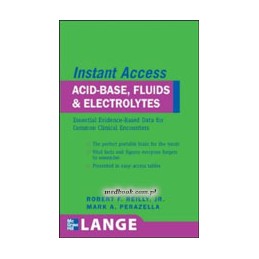- Reduced price

Order to parcel locker

easy pay


 Delivery policy
Delivery policy
Choose Paczkomat Inpost, Orlen Paczka, DHL, DPD or Poczta Polska. Click for more details
 Security policy
Security policy
Pay with a quick bank transfer, payment card or cash on delivery. Click for more details
 Return policy
Return policy
If you are a consumer, you can return the goods within 14 days. Click for more details
Publishers Note:: Products purchased from Third Party sellers are not guaranteed by the publisher for quality, authenticity, or access to any online entitlements included with the product.
Essential Evidence-Based Data for Common Clinical Encounters
This is very useful for providers who desire a fast review of fluid, electrolyte, and acid-base disorders without asking for in-depth information. Background information about pathophysiology and references are not included, but are not needed. This makes the book unique and quite different from other available resources on the topic. 3 Stars.--Doodys Review Service
Make sense of acid-base and electrolytes with this compact, on-the-go guide--filled with clinical facts, figures, and data.
In this ultra-convenient resource, the authors have distilled down the most relevant insights from their acclaimed text Nephrology in 30 Days, giving you a complete, yet concise overview of acid-based and electrolytes--supported by evidence-based findings.
Youll find at-a-glance tables and a bulleted format that puts key diagnostic and clinical information right at your fingertips. This one-stop guide gets you up to speed on the major issues in acid-base and electrolyte disturbances, from metabolic acidosis to serum calcium disorders. Its the perfect clinical companion to more in-depth acid-base texts--one that goes beyond educational principles to focus on the real world of clinical medicine and patient management.
Data sheet
1. Body fluid compartments
2. Intravenous solutions
3. General principles
4. Assessing extracellular fluid volume
5. Fluid resuscitation
6. Clinical examples of fluid resuscitation
1. Introduction
2. Regulation of Na+ transport in kidney
3. Disorders associated with increased total body Na+ (ECF volume expansion)
4. Clinical manifestations of increased total body Na+ (ECF volume expansion)
5. General approach to the edematous patient
6. General treatment of the edematous patient
7. Clinical manifestations of decreased total body Na+ (ECF volume depletion)
8. General approach to the volume depleted patient
9. General Treatment of the Volume Depleted Patient
1. Introduction
2. Hyponatremia
3. Etiology of hyponatremia
4. Signs and symptoms
5. Diagnosis
6. Treatment
7. Hypernatremia
8. Etiology
9. Signs and symptoms
10. Diagnosis
11. Treatment
1. Introduction
2. Sites of diuretic action in kidney
3. Diuretic resistance
4. Clinical conditions associated with diuretic resistance
5. Treatment of diuretic resistance
1. Introduction
2. K+ homeostasis
3. Role of K+ in the resting membrane potential
4. Cellular K+ distribution
5. K+ handling by the kidney
6. Factors controlling renal K+ excretion
7. Hypokalemia8. Etiology
9. Increased cellular K+ uptake
10. Increased renal K+ losses
11. Approach to the patient
12. Clinical manifestations
13. Treatment
14. Hyperkalemia
15. Etiology
16. Approach to the patient
17. Clinical manifestations
18. Treatment
1. Acid-Base Chemistry and Biology
2. The Bicarbonate Buffering System
3. Acid Excretion by the Kidney
4. Clinical Approach to the Patient with an Acid-Base Disorder
5. Pathophysiology, Compensation and Consequences
6. Use of the Serum and Urine Anion Gap in the Differential Diagnosis of Metabolic Acidosis
7. Differential Diagnosis of Metabolic Acidosis
8. Causes of Metabolic Acidosis
9. Treatment of Metabolic Acidosis
1. Introduction
2. Maintenance of Metabolic Alkalosis
3. Clinical Features
4. Differential Diagnosis
5. Cl--Responsive and Cl--Resistant Causes of Metabolic Alkalosis
6. Treatment
1. Respiratory Disturbances
2. Respiratory Acidosis
3. Respiratory Alkalosis
4. Mixed Disturbances
1. Regulation
2. Hypercalcemia
3. Hypocalcemia
1. Regulation
2. Hyperphosphatemia
3. Hypophosphatemia
